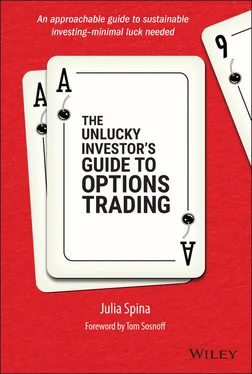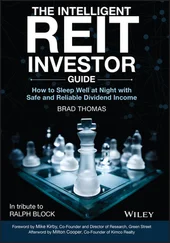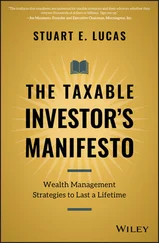1 Cover
2 Title Page The Unlucky Investor’s Guide to Options Trading Julia Spina Coauthored by Anton Kulikov Foreword by Tom Sosnoff
3 Copyright
4 Dedication
5 Foreword
6 Preface
7 Acknowledgments
8 About the Authors
9 Introduction: Why Trade Options?
10 Chapter 1: Math and Finance Preliminaries Stocks, Exchange‐Traded Funds, and Options The Efficient Market Hypothesis Probability Distributions The Black‐Scholes Model The Greeks Covariance and Correlation Additional Measures of Risk Notes
11 Chapter 2: The Nature of Volatility Trading and Implied Volatility Trading Volatility The States of VIX IV Reversion Takeaways Notes
12 Chapter 3: Trading Short Premium Background: A Note on Visualizing Option Risk Background: A Note on Quantifying Option Risk Trading in High IV Number of Occurrences Portfolio Allocation and Position Sizing Active Management and Efficient Capital Allocation Takeaways Notes
13 Chapter 4: Buying Power Reduction Takeaways Notes
14 Chapter 5: Constructing a Trade Choose an Asset Universe Choose an Underlying Choose a Contract Duration Choose Defined or Undefined Risk Choose a Directional Assumption Choosing a Delta Takeaways Notes
15 Chapter 6: Managing Trades Managing According to DTE Managing According to a Profit or Loss Target Comparing Management Techniques and Choosing a Strategy A Note about Long‐Term Risk Takeaways Notes
16 Chapter 7: Basic Portfolio Management Capital Allocation and Position Sizing The Basics of Diversification Maintaining Portfolio Greeks Takeaways Notes
17 Chapter 8: Advanced Portfolio Management Advanced Diversification Balancing Capital According to POP Constructing a Sample Portfolio Takeaways Notes
18 Chapter 9: Binary Events Option Strategies for Binary Events Takeaways Note
19 Chapter 10: Conclusion and Key Takeaways
20 AppendixI. The Logarithm, Log‐Normal Distribution, and Geometric Brownian Motion, with contributions from Jacob Perlman II. Expected Range, Strike Skew, and the Volatility Smile III. Conditional Probability IV. The Kelly Criterion, derivation courtesy of Jacob Perlman Notes
21 Glossary of Common Tickers, Acronyms, Variables, and Math Equations
22 References
23 Index
24 End User License Agreement
1 Chapter 1 Table 1.1 The definitions, conditions for profitability, and directional ass... Table 1.2 The probability of each number appearing on each die in the three ...
2 Chapter 2Table 2.1 Two underlyings with the same price and put contracts on each unde...Table 2.2 IV overstatement of realized moves for six assets from 2016–2021. ...Table 2.3 Rates thats different assets experienced daily returns larger than...
3 Chapter 3Table 3.1 Two example short strangles. For Strangle A, CVaR estimates losing...Table 3.2 How often the VIX fell in a given range from 2005–2021.Table 3.3 The POPs and average P/Ls in different IV ranges for 45 DTE 16  SP...Table 3.4 Guidelines for allocating portfolio capital according to market IV...Table 3.5 Comparison of management strategies for 45 DTE 16
SP...Table 3.4 Guidelines for allocating portfolio capital according to market IV...Table 3.5 Comparison of management strategies for 45 DTE 16  SPY strangles f...
SPY strangles f...
4 Chapter 4Table 4.1 Three examples of approximate 45 DTE 16  strangle trades with diff...Table 4.2 Two portfolios with the same net liquidity but different amounts o...Table 4.3 Example trades that offer bullish directional exposure. Assume tha...
strangle trades with diff...Table 4.2 Two portfolios with the same net liquidity but different amounts o...Table 4.3 Example trades that offer bullish directional exposure. Assume tha...
5 Chapter 5Table 5.1 Pricing, bid‐ask spread, and daily volume data for different equit...Table 5.2 General pros and cons for stock and ETF underlyings.Table 5.3 Options P/L and probability of profit (POP) statistics 45 days to ...Table 5.4 Two sample options underlyings with the same IV but differing stoc...Table 5.5 Data for 16  SPY strangles with different durations from April 20,...Table 5.6 Comparison of defined and undefined risk strategies.Table 5.7 Portfolio allocation for defined and undefined risk strategies wit...Table 5.8 Examples of popular short options strategies with the same delta o...Table 5.9 Example of a 16
SPY strangles with different durations from April 20,...Table 5.6 Comparison of defined and undefined risk strategies.Table 5.7 Portfolio allocation for defined and undefined risk strategies wit...Table 5.8 Examples of popular short options strategies with the same delta o...Table 5.9 Example of a 16  SPY strangle and a 16
SPY strangle and a 16  SPY iron condor with 10
SPY iron condor with 10  w...Table 5.10 Initial credits for the 16
w...Table 5.10 Initial credits for the 16  SPY strangle and the 16
SPY strangle and the 16  SPY iron con...Table 5.11 Statistical comparison of 45 DTE 16
SPY iron con...Table 5.11 Statistical comparison of 45 DTE 16  SPY iron condors with differ...Table 5.12 Average BPR comparison of 45 DTE 16
SPY iron condors with differ...Table 5.12 Average BPR comparison of 45 DTE 16  SPY strangles and 45 DTE 16
SPY strangles and 45 DTE 16  Table 5.13 Statistical comparison of 45 DTE SPY strangles of different delta...Table 5.14 Average BPRs of 45 DTE SPY strangles with different deltas, sorte...Table 5.15 Probability of incurring a loss exceeding the BPR for 45 DTE SPY ...Table 5.16 Comparison of strike prices for two 30 DTE 16
Table 5.13 Statistical comparison of 45 DTE SPY strangles of different delta...Table 5.14 Average BPRs of 45 DTE SPY strangles with different deltas, sorte...Table 5.15 Probability of incurring a loss exceeding the BPR for 45 DTE SPY ...Table 5.16 Comparison of strike prices for two 30 DTE 16  call options with ...
call options with ...
6 Chapter 6Table 6.1 Statistics for 45 DTE 16  SPY strangles from 2005–2021 managed at ...Table 6.2 Statistics for 45 DTE 16
SPY strangles from 2005–2021 managed at ...Table 6.2 Statistics for 45 DTE 16  SPY strangles from 2005–2021 managed at ...Table 6.3 Average daily P/L and average duration for the contracts and manag...Table 6.4 Statistics for 45 DTE 16
SPY strangles from 2005–2021 managed at ...Table 6.3 Average daily P/L and average duration for the contracts and manag...Table 6.4 Statistics for 45 DTE 16  SPY strangles from 2005–2021 managed at ...Table 6.5 Statistics for 45 DTE 16
SPY strangles from 2005–2021 managed at ...Table 6.5 Statistics for 45 DTE 16  SPY strangles from 2005–2021 managed eit...Table 6.6 Qualitative comparison of different management strategies.
SPY strangles from 2005–2021 managed eit...Table 6.6 Qualitative comparison of different management strategies.
7 Chapter 7Table 7.1 Statistics for 45 DTE 16  strangles from 2011–2020, managed at exp...Table 7.2 Two sample portfolios, each containing some percentage of market E...Table 7.3 The five‐year correlation history for the assets in Portfolios A a...Table 7.4 Historic correlations between two market ETFs (SPY, QQQ) and the c...Table 7.5 The probability of outlier losses (worse than 200% of the initial ...Table 7.6 Historic correlations among two market ETFs (SPY and QQQ), a gold ...Table 7.7 The probability of outlier losses (worse than 200% of the initial ...Table 7.8 Daily performance statistics for five portfolios passively investe...
strangles from 2011–2020, managed at exp...Table 7.2 Two sample portfolios, each containing some percentage of market E...Table 7.3 The five‐year correlation history for the assets in Portfolios A a...Table 7.4 Historic correlations between two market ETFs (SPY, QQQ) and the c...Table 7.5 The probability of outlier losses (worse than 200% of the initial ...Table 7.6 Historic correlations among two market ETFs (SPY and QQQ), a gold ...Table 7.7 The probability of outlier losses (worse than 200% of the initial ...Table 7.8 Daily performance statistics for five portfolios passively investe...
Читать дальше

 SP...Table 3.4 Guidelines for allocating portfolio capital according to market IV...Table 3.5 Comparison of management strategies for 45 DTE 16
SP...Table 3.4 Guidelines for allocating portfolio capital according to market IV...Table 3.5 Comparison of management strategies for 45 DTE 16  SPY strangles f...
SPY strangles f... strangle trades with diff...Table 4.2 Two portfolios with the same net liquidity but different amounts o...Table 4.3 Example trades that offer bullish directional exposure. Assume tha...
strangle trades with diff...Table 4.2 Two portfolios with the same net liquidity but different amounts o...Table 4.3 Example trades that offer bullish directional exposure. Assume tha... SPY strangles with different durations from April 20,...Table 5.6 Comparison of defined and undefined risk strategies.Table 5.7 Portfolio allocation for defined and undefined risk strategies wit...Table 5.8 Examples of popular short options strategies with the same delta o...Table 5.9 Example of a 16
SPY strangles with different durations from April 20,...Table 5.6 Comparison of defined and undefined risk strategies.Table 5.7 Portfolio allocation for defined and undefined risk strategies wit...Table 5.8 Examples of popular short options strategies with the same delta o...Table 5.9 Example of a 16  SPY strangle and a 16
SPY strangle and a 16  SPY iron condor with 10
SPY iron condor with 10  w...Table 5.10 Initial credits for the 16
w...Table 5.10 Initial credits for the 16  SPY strangle and the 16
SPY strangle and the 16  SPY iron con...Table 5.11 Statistical comparison of 45 DTE 16
SPY iron con...Table 5.11 Statistical comparison of 45 DTE 16  SPY iron condors with differ...Table 5.12 Average BPR comparison of 45 DTE 16
SPY iron condors with differ...Table 5.12 Average BPR comparison of 45 DTE 16  SPY strangles and 45 DTE 16
SPY strangles and 45 DTE 16  Table 5.13 Statistical comparison of 45 DTE SPY strangles of different delta...Table 5.14 Average BPRs of 45 DTE SPY strangles with different deltas, sorte...Table 5.15 Probability of incurring a loss exceeding the BPR for 45 DTE SPY ...Table 5.16 Comparison of strike prices for two 30 DTE 16
Table 5.13 Statistical comparison of 45 DTE SPY strangles of different delta...Table 5.14 Average BPRs of 45 DTE SPY strangles with different deltas, sorte...Table 5.15 Probability of incurring a loss exceeding the BPR for 45 DTE SPY ...Table 5.16 Comparison of strike prices for two 30 DTE 16  call options with ...
call options with ... SPY strangles from 2005–2021 managed at ...Table 6.2 Statistics for 45 DTE 16
SPY strangles from 2005–2021 managed at ...Table 6.2 Statistics for 45 DTE 16  SPY strangles from 2005–2021 managed at ...Table 6.3 Average daily P/L and average duration for the contracts and manag...Table 6.4 Statistics for 45 DTE 16
SPY strangles from 2005–2021 managed at ...Table 6.3 Average daily P/L and average duration for the contracts and manag...Table 6.4 Statistics for 45 DTE 16  SPY strangles from 2005–2021 managed at ...Table 6.5 Statistics for 45 DTE 16
SPY strangles from 2005–2021 managed at ...Table 6.5 Statistics for 45 DTE 16  SPY strangles from 2005–2021 managed eit...Table 6.6 Qualitative comparison of different management strategies.
SPY strangles from 2005–2021 managed eit...Table 6.6 Qualitative comparison of different management strategies. strangles from 2011–2020, managed at exp...Table 7.2 Two sample portfolios, each containing some percentage of market E...Table 7.3 The five‐year correlation history for the assets in Portfolios A a...Table 7.4 Historic correlations between two market ETFs (SPY, QQQ) and the c...Table 7.5 The probability of outlier losses (worse than 200% of the initial ...Table 7.6 Historic correlations among two market ETFs (SPY and QQQ), a gold ...Table 7.7 The probability of outlier losses (worse than 200% of the initial ...Table 7.8 Daily performance statistics for five portfolios passively investe...
strangles from 2011–2020, managed at exp...Table 7.2 Two sample portfolios, each containing some percentage of market E...Table 7.3 The five‐year correlation history for the assets in Portfolios A a...Table 7.4 Historic correlations between two market ETFs (SPY, QQQ) and the c...Table 7.5 The probability of outlier losses (worse than 200% of the initial ...Table 7.6 Historic correlations among two market ETFs (SPY and QQQ), a gold ...Table 7.7 The probability of outlier losses (worse than 200% of the initial ...Table 7.8 Daily performance statistics for five portfolios passively investe...










